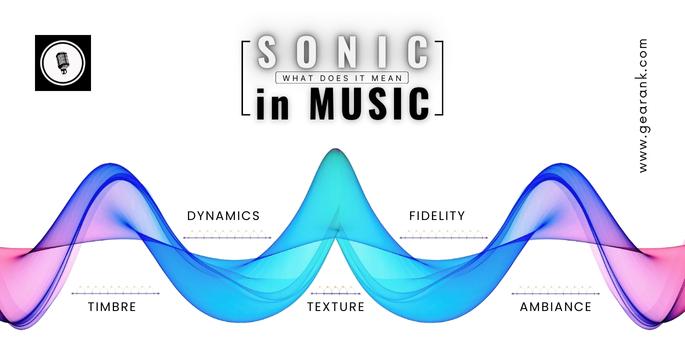What Does Sonically Mean in Music Answered Here

SonicallySonically refers to the characteristics of sound. In music, it refers to the quality or style of a song. It speaks about timbre, dynamics, texture, fidelity, ambiance, tone, and more. |
When discussing music, you'll often hear about tone, brightness, or warmth. These terms describe music sonically, referring to the specific characteristics and quality of the overall sound or specific instruments and parts.
"Sonically" is a term that describes the character of sound, and when talking about sound, the meaning of adjectives and verbs (like bright and dark) change.
Knowing how to communicate the characteristics of audible sound is important in live performances and music production in general.
So, in this article, I'll give you the low down of what sonically is and how it's used in music.
What Does Sonically Mean in Music?
Sonically is a term that denotes the focus of the statement is on sound - the way it is produced, perceived, and organized.
It came from the root word "sonic", from the latin sonus which means sound. It is generally used to refer to the movement of sound waves.
Sound creates movements or vibrations in the air that resonate within the audible frequency range.
Take, for example, a large speaker with a small object in front of it. As the music plays loud, you can see that the object will be moving. This is a physical manifestation of sonic vibration.
Our ears perceive these vibrations as sound, and these sound waves have particular qualities that we describe using familiar words.
When sonically is used, you know that the statement is talking about sound, and this includes music in general.
It is a term often thrown around when people describe music, be it in casual conversations or a music production setting.
Much of the unspoken communication between the sound engineer and artist / improviser takes place sonically. But it still is better if sound quality is communicated properly.
Below are some examples of how words inherent different meanings when referring to music:
- When musicians talk about "Lows" sonically, they are referring to the bass frequencies. "Highs" refer to the higher frequencies.
- Sonically, the adjective "clean" means the sound is without any effect, usually referring to electric guitar tone. "Dirt," on the other hand, refers to sound with a distortion effect applied.
- "Bright" means having a trebly sound, while "dark" means having more emphasis on the lower frequencies.
- Sounding "crisp" means the sound has good treble and attack. A "warm" tone emphasizes more of the lower mids to low frequencies.
These are but a few of the many words that change their meaning when musicians communicate about music.
Subsonic and Ultrasonic
While we do hear sound, there are certain sound waves we can't hear. These are called subsonic or infrasonic frequencies, sound waves with a frequency range under 20 Hz.
The frequencies above the 20 kHz range, on the other hand, are classified as ultrasonic frequencies.
Both subsonic and ultrasonic frequencies are past the human-perceivable sound range. Interestingly, these sound waves that we don't hear, we can still actually somewhat feel. Especially when they cause substantial vibrations.
Ultrasonic sound waves are used in other applications. Navigation, imaging, and communication are some of the few fields in which ultrasonic is used. Another example is its usage in the medical field for sonograms.
Note that ultrasonic and supersonic are actually different things. Ultrasonic refers to the movement of sound frequency, while supersonic refers to the speed of a fast moving object.
To be specific, supersonic is talking about speed that exceeds the speed of sound (at sea level). When an object hits this speed, it will produce a sonic boom that causes a loud and powerful shock wave. Speaking of sonic boom, this is the phrase commonly associated with sonic, and is the reason why sonic became associated with speed instead of sound.
Technically speaking, sonic is about sound and not speed. This makes iconic game characters like Sonic the Hedgehog a bit awkward if you look at the true meaning.
The Importance of Sound Waves in Music
Music involves sonics, and technically speaking, sonics dictate the shift in a song's character or overall feel. The way a sonic wave is projected also substantially impacts music quality.
It affects the quality and texture of the music, as well as the emotions it evokes. Different tones, timbres, dynamics, and other musical techniques are critical to creating good and enjoyable music.
By manipulating different elements of sound, you can elicit various emotional responses. This is the reason why modern electronic dance music often has the lower frequencies pumped up to ensure the beat gets felt by the audience.
For music to sound good, it should have a good balance of timbre, dynamics, texture, fidelity, and ambiance. This involves using effects like a good reverb algorithm and reverse engineering older works of music to reproduce their warmth in digital form, for modern music production use.
Managing the various frequencies allows a music producer to enhance the song's quality and sonic aesthetic This is why a strong case can be made for visual monitoring, sound waves are transformed visually for the producer to make the correct adjustments. Ultimately, rendering pieces of the overall music becomes easier.
Carefully determining and selecting the sonic frequencies to cut and boost plays a big role, especially in particular musical genres.
For example, you can use a high-pass or low-pass filter to highlight specific frequencies and create a more cohesive mix. This will significantly impact the vibe or feel of a song when you're mixing or mastering music.
Sonically Appealing Music
Different genres consider different sonic characteristics as appealing. In dance tracks, for example, they prefer a deep, vibrating bass and a strong, thumping beat, which DJs love. The powerful sound produces a mini shock wave that have a physical effect, moving through the room. It encourages and hypes the audience to move along with the music. Still, this heavy bass would not be welcome in traditional styles like folk or country.
Note that there are no strict standards to how a particular genre should sound, except maybe for classical, but there are distinct sonic characteristics that different styles are known for. Rock music is expected to be in-your-face and gritty, instrumental music would be more ambient and expressive, and so on and so forth.
Furthermore, a sonically appealing sound isn't just limited to music. Sonics can also be used to create a relaxing and calming ambient sound. Ancient cultures harnessed the energy of sound waves to create music that is soothing to listen to.
They have been incorporating them into mindfulness practices for a long time. A popular example is the Tibetan Healing Bowls. The sound emits sonic vibrations that are known for their calming properties. This is common, especially in many ancient cultures. It is said that music created by these bowls is said to resonate with the body, consequently healing it.
Cohesion
To ensure that every track is sonically musical, it should be cohesive and have a good balance of the different frequencies and musical elements. This is important when creating songs, and when lining up songs for an album. The instruments should line up properly for the songs, while the tracks must flow naturally from one to the next to create a cohesive feel.
They should fit together like puzzle pieces as you listen to them as a whole. To achieve this, you must combine creative lyrical threads, emotional resonance, instrumentation, and professional music production.
How Different Types of Music Use Sonic Elements
Different types of music utilize sonic frequencies differently. These differences make each type unique, and they define the different kinds of genres. Here's a list of some musical genres and how they differ sonically.
-
Classical Music: It's a genre of music that emphasizes the richness of orchestral timbres and intricate textures of sound. It's focused on instrumentation, mainly by using acoustic instruments. It takes advantage of the instrument's structure and the sonic space to create sound and resonance.
-
Jazz: A type of genre that encourages improvisation, syncopation, and harmonic complexity in its songs. A jazz improviser has a sonically clean tone (with a light overdrive at times). This allows for more expressive playing and enhances the spontaneous nature of the music.
-
Rock and Metal: Distinguished by aggressive and energetic dynamics. Rock & Metal creates an auditory explosion that is unlike any other genre. It features a more extreme version of using overdrive and distortion to enhance the rawness and visceral impact of this music.
-
Electronic Music: Using only a laptop, you can now manipulate, create, and produce music. This kind of music is characterized by its synthesized sounds, electronic beats, and other digital effects. These elements help create an immersive sonic landscape. For example, the annual Ultra Music Festival in Miami. It showcases a lot of electronic music performances, along with other genres.
Final Thoughts
To sum it all up, music is defined by a lot of factors, and as humans, we use the term sonically to refer to these characteristics.
When creating music, the most fundamental thing you must strive for is good sound quality. It has to be cohesive to deliver your message to your listeners creatively.
To achieve this, musicians and producers communicate with each other, using terms that change their definition to describe what they are hearing.
Contributors:
- Jerome Arcon - Co-Writer
- Jerry Borillo - Illustrator












